Uganda’s population is estimated at 34.9 million. It has one of the youngest and most rapidly growing populations in the world with 70% of the total population being less than 25 years old and children below 18 years constituting 56.7%. The Uganda AIDS Indicator Survey (2011) estimates HIV prevalence at 7.3% from 6.4% (UAIS, 2004). The number of persons in the country living with HIV has continued to increase, from 1.4 million in 2013 to 1.56 million in 2015. This rise is attributed to new HIV infections, high enrollment in HIV care and treatment, good retention and reduced HIV-related morbidity.
Uganda has adopted key global strategies to end the HIV epidemic by 2030: “Towards zero new infections, zero HIV/AIDS-related mortality and morbidity and zero discrimination”; the UNAIDS treatment targets of 90-90-90 by 2020; and efforts “Towards an AIDS-free Generation”. The Uganda country report (2015–2016) reported reduction of new infections amongst children living with HIV from 12,000 in 2013 to 3,500 in 2015. In addition, since 2011 new infections among exposed infants have reduced by 86%, the highest reduction in eastern and southern Africa. Adaptation of Test and Treat for all HIV-positive children has led to increased coverage of children living with HIV, from 54% in 2014 to 66% (60,124 / 92,370) by end of June 2016.
Even with these gains, there are still challenges to be overcome. Among children under 2 years initiated on ART in 2015, 23% were lost to follow up in the first year. For children under 5 years, the viral suppression rates were at 70% compared with 90% for adults. This is coupled with a higher sample rejection rate of 7% compared with 5% for adults. Only 39% of the health facilities had adolescent-friendly services. This shows that despite scaling up the PMTCT programme and roll-out of HIV services to lower-level health facilities, there are still gaps in paediatric and adolescent HIV testing, linkage, care and treatment and retention on ART.
ART coverage for children and adolescents living with HIV is low compared with adults, where ANECCA implemented a regional project to improve coverage and quality of care.
.


